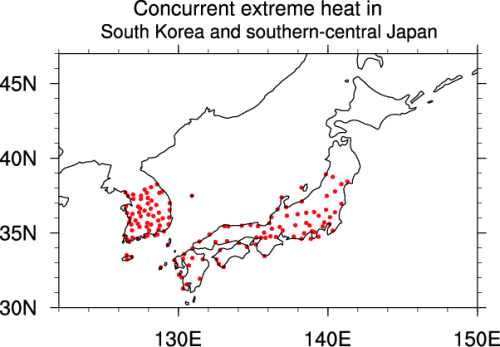Two Types of Mid-latitude Wave Trains Lead to Extreme Heat in South Korea and Southern-Central Japan
Date:2019-05-10
Global climate change has strongly increased the worldwide frequency of extreme heat in recent decades. South Korea and southern-central Japan are also frequently affected by extreme heat, and the extreme heat in these two regions tend to occur simultaneously. A scientific collaboration of climatologists examined the large-scale circulation leading to the concurrent extreme heat over South Korea and Southern-Central Japan. Their findings have been published in Journal of Climate recently.

Concurrent extreme heat over South Korea and Souther-Central Japan. (Image by Ruidan Chen)
"The concurrent extreme heat result from a deep anomalous anticyclone over East Asia, which induces anomalous subsidence and consequent higher surface temperature," said Ke XU, the first author on the paper, who is a postdoc working with Prof. Riyu LU and Prof. Jiangyu MAO in the Institute of Atmospheric Physics, Chinese Academy of Sciences.
XU also noted that the anomalous anticyclone is initiated by wave trains originating from upstream regions, which propagate eastward along the Asian westerly jet in the upper troposphere. "These wave trains can be categorized into two types that are characterized by the precursor anticyclonic and cyclonic anomalies, respectively, over central Asia," XU said. "The two types of wave pattern are indicative to the occurrence of EH over South Korea and southern–central Japan."
The researchers further found that the distinction between these two types of wave train is modulated by the Asian westerly jet. "The Asian westerly jet, as the basic flow, can determine not only the propagation, but also the horizontal structure of the Rossby wave in terms of spatial scale and geographical distribution." XU said.
This work reveals the unique characteristics of the circulation responsible for extreme heat in South Korea and southern–central Japan. The wave patterns identified in this study are different from the patterns associated with the extreme heat in some other regions such as Europe, North America and China.
Other contributors include Prof. Baek-Jo Kim of the National Institute of Meteorological Sciences in South Korea, Prof. Jong-Kil PARK and Prof. Jae-Young BYON of the Inje University in South Korea, Dr. CHEN Ruidan of Sun Yat-sen University in China and Dr. Eun-Byul KIM of the Inje University in South Korea.
Reference: Xu, K., R. Lu, B. Kim, J. Park, J. Mao, J. Byon, R. Chen and E. Kim, 2019: Large-scale circulation anomalies associated with extreme heat in South Korea and southern–central Japan. Journal of Climate, 32, 2747–2759. https://doi.org/10.1175/JCLI-D-18-0485.1
Meidai contact: Ms. LIN Zheng, jennylin@mail.iap.ac.cn
